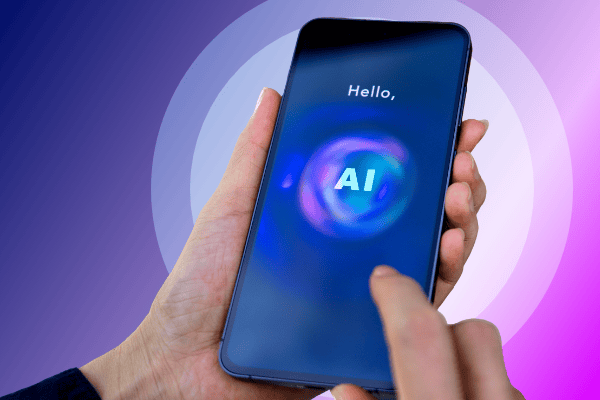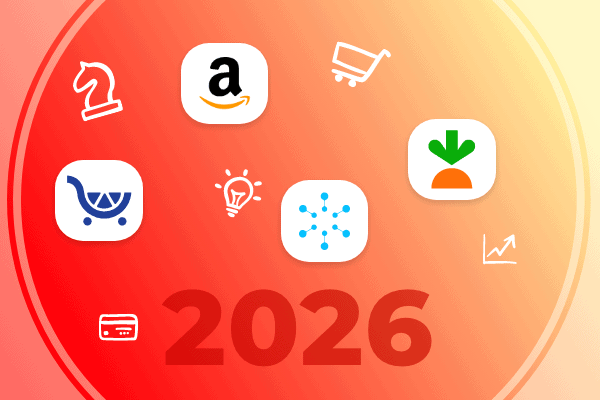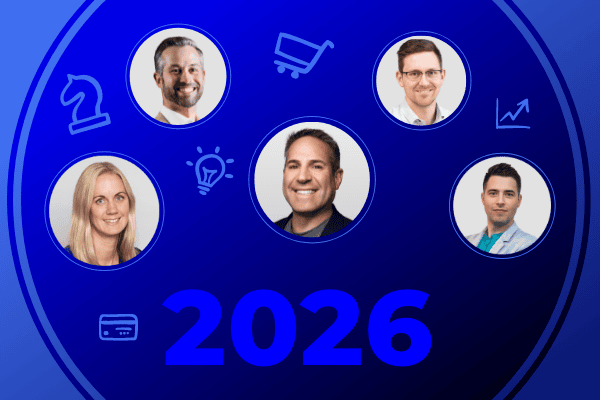Summary
Prime Day 2025 isn’t just noisy—it’s a proving ground. If your commerce media strategy still operates in silos, you’re missing the moment. Retail, search, and social have to talk to each other because consumers aren’t waiting for your funnel logic to catch up. Winning this year means syncing every channel to meet intent wherever it shows up.
Last updated: November 10, 2025
Every year, Prime Day gets louder.
More dollars. More eyeballs. More pressure to hit the mark across every screen a consumer touches. And now, it’s not just about doing more—it’s about doing it together. Because Prime Day, which in 2025 will run for an unprecedented four days July 8-11, isn’t just a retail media test anymore, it’s a commerce media moment. According to Adobe Analytics (2025), U.S. online spend during the July 8–11 Prime event reached $24.1B, up 30.3% year over year.
Here’s the ever-evolving challenge: Today’s consumer doesn’t move in a straight line. They bounce between Instagram and Google, get distracted by a deal on Amazon, click out, come back through TikTok, and maybe search again two weeks later. What looks fragmented to a marketer is completely normal to the consumer. The funnel is still a useful way to describe what’s happening in aggregate, but for individual consumers, the journey feels more like Chutes and Ladders: unpredictable drops, sudden leaps, and nonlinear paths that defy traditional sequence. A recent report from eMarketer (2024) projects that off-site retail media will account for more than one-fifth of retail media ad spend in 2025—supporting cross-channel planning beyond retailers’ walled gardens.
The customer journey is no longer a straight line
As defined in the 2025 State of Retail Media Report, commerce media is “a fully integrated, omnichannel layer” that brings together retail, search, and social under one outcome: drive measurable sales. With the customer journey now so non-linear and elusive, commerce media helps brands surround their customers and align with how people actually shop now: unpredictably, asynchronously, and across multiple platforms.
Commerce media is an approach designed to adapt to the consumer, rather than forcing them into a predetermined sequence.
The promise of commerce media is big: a system where all channels talk to each other, campaigns flow across surfaces, and no moment of intent goes to waste. But the execution gap is real. Only 25% of retail media marketers say they’ve achieved full-funnel maturity. Limited integration, fragmented reporting, and siloed teams continue to block progress.
The opportunity is there. The intent is there. But without operational coordination, the benefits of commerce media stay theoretical. Prime Day is the kind of moment that exposes that gap—and gives marketers a reason to close it.
Micro-answer: Sync retail, search, and social around outcomes.
What do you need — upstream & downstream— from your channel partners?
- Prime Day exposes where channel handoffs break. Unify signals and pacing across teams.
- Coordinate budgets, creative, and audiences so each channel can start, support, or finish the journey as consumer intent shifts—minimizing waste from misaligned KPIs and maximizing conversion lift across the four-day event.
If you own one of these channels—retail, search, or social—it’s no longer enough to just optimize for your own KPIs. Your performance depends on what the other two teams are doing. That’s not theory. That’s the reality of fragmented consumer behavior and channel-fluid shopping. Yet only 24% of organizations have fully integrated their retail media with other ad channels, signaling how far we still have to go.
Forget the old funnel logic. On any given day, any channel can kick off discovery, support consideration, or drive the conversion. No one owns a stage anymore. What matters is that each channel gets what it needs—from the others—to meet the consumer with relevance and context.
The next three sections break that down: what each channel needs from the rest of the system to make the most of Prime Day, and the rest of the retail calendar.
Of course, those other channel teams have their own strategy, goals, and contracts. They might not be able to fully coordinate their plans with your needs. But you should still communicate. By letting them know how they could boost you — and your willingness to reciprocate — it at least gets the conversation going. Even if they adjust their plans slightly to align with your channel’s goals, it will be worth it.
Upstream/downstream: What does retail media need from paid search and social advertising?
- Retail media is most efficient when upper-funnel demand is warmed.
- Seed familiarity upstream and re-engage downstream; social frames desire, search validates and compares, retail media closes.
Retail media may be where the conversion happens, but it only works when the consumer shows up ready.
Sometimes, retail media doesn’t need any help. It can create awareness, nurture consideration, and drive conversion all within the retailer environment. Especially during peak events like Prime Day—or major promotional pushes throughout the year—a well-placed Sponsored Brand ad or homepage feature can deliver the entire journey in one interaction. And increasingly, retail media doesn’t even need to stay onsite—more than one-fifth of retail media spend in 2025 will be off-site
But that’s not always the case. Often, retail media doesn’t get the consumer at the beginning—it gets them mid-scroll, mid-decision, or mid-doubt. The impression it delivers is more effective when something has already been seeded upstream. And if a consumer clicks but doesn’t buy, it relies on the other channels to follow up and bring them back.
Off-site retail media spend is growing ~42% in 2025—evidence to sync beyond retailer sites. Retail media teams don’t need paid search and social advertising to stay in their so-called funnel lanes. It needs them to fill in the gaps when the journey zigzags. And on Prime Day, it almost always does.
Retail media’s upstream needs
Retail media performs best when the consumer already knows what they’re looking at.
Retail media often works best when it doesn’t have to introduce the product cold. That doesn’t mean it can’t—but it’s far more efficient when the consumer arrives with some familiarity. That’s where paid search and social advertising play a critical role: helping shape interest, expectation, and intent before the retailer click ever happens.
From paid search, retail media needs precision and intent refinement. If a consumer searches “lightweight foundation,” and a search ad introduces them to a brand or product line, that context should carry into the PDP. When retail media doesn’t have to start from scratch, every dollar works harder.
For instance, a shopper might search “best insulated tumblers for summer” on Google and click through to a brand site or third-party article. They don’t purchase right away, but that click primes their interest. When they later see that same tumbler brand featured in a Sponsored Product ad during Prime Day, it feels familiar and trusted, not random.
From social advertising, it needs emotional framing. Social helps create desire, surface new occasions, and bring relevance to categories that don’t always get attention. A consumer who’s been warmed up by a creator’s story or a product demo doesn’t land on a PDP needing to be sold—they land ready to evaluate.
One example: a creator on Instagram posts a packing hack video featuring a foldable duffel bag with a unique zipper pouch. The post goes viral, and viewers don’t immediately click through to buy—but they remember the product. A week later, during Prime Day, a Sponsored Brand placement featuring that exact duffel drives strong click-through because social already seeded the story.
Retail media’s downstream needs
If a consumer doesn’t convert right away, retail media can’t recover on its own.
Even with the right message, timing, and product, Prime Day traffic is volatile. consumers bounce. They compare. They hesitate. And when they do, retail media needs support to keep them in the consideration cycle.
From paid search, retail media needs continued visibility, especially in the moments when the consumer pivots to comparison. If they leave the PDP and search “best sunscreen under $25,” paid search should be ready to recapture them, ideally reinforcing the product they just saw or nudging them toward the next-best fit.
Consider when a shopper lands on a PDP for a pet grooming kit but clicks away to compare. If they later search “best grooming kits for dogs under $50,” a paid search ad that includes the same product or its bundle variant can reignite interest and steer them back to purchase.
From social advertising, it needs a narrative-based follow-up. A retargeting ad is fine, but what works better is a nudge wrapped in content—a quick tip, a creator story, or a lifestyle moment that brings the product back into view without repeating the pitch. The goal isn’t just recall—it’s reinforcement.
Take a case where a consumer views a noise-canceling headphone product page but doesn’t check out. If, later, a creator shows the same headphones in a “work-from-home setup” video with a tip about sound quality, that social moment can bring the product back into context without repeating the pitch.
Upstream/downstream: What does paid search need from retail media and social advertising?
- Paid search performs best when retail media and social pass stronger signals upstream and share learnings downstream.
- Warm demand upstream; validate and convert in search.
- Search needs enriched signals (onsite/off-site audiences, promo flags, creative hooks) to prioritize queries and tailor ad copy; align offers with PDP claims to reduce bounce; share search-term learnings back to social and retail for creative refreshes and suppression lists.
Paid search may be built for efficiency, but it performs best when it’s not working alone.
No channel delivers more consistent intent signals than paid search. It’s where consumers go to ask specific questions, compare features, and close in on a decision. But the success of a paid search campaign often depends on what happens around it, not just in the moment of the query, but before and after it, too. And 88% of consumers say they use Google to validate pricing during big shopping events, even while actively browsing retailer deals—putting paid search in the perfect position to catch mid-decision pivots.
Sometimes, paid search can carry the full weight of performance. A well-timed campaign around Prime Day, or any high-volume event, can capture high-intent traffic and move it efficiently to conversion. But too often, those campaigns are operating without the full picture. What was promised in the ad doesn’t match what’s on the PDP. What’s ranking high isn’t what’s actually moving. And the signals from retail and social aren’t informing the strategy.
Paid search isn’t just a tactical channel. In a commerce media world, it’s a responsive channel. While search ads on retailer platforms like Amazon are a major part of retail media, this section focuses on paid search on traditional engines like Google, still one of the most important digital marketing investments for brands. And it needs better inputs.
Paid search’s upstream needs
Search ads work harder when other channels shape the demand first.
From retail media, paid search needs performance visibility. Which SKUs are converting? Which variations are moving fastest? Which promos are actually live at the retailer level? When retail media performance informs paid search priorities, brands can promote what’s proven, not just what’s planned.
Let’s say retail media reporting shows a particular SKU—say, lemon-scented dish soap—is flying off the shelves. That signal can guide the paid search team to prioritize keywords like “lemon dish soap for grease,” helping ensure search ads are aligned to what’s actually converting, not just what’s forecasted. Or maybe the retail media team sees that retailer searches for bathing suits are starting earlier this year than anticipated. That’s great insight for the search team to boost those ads on their side.
From social advertising, it needs demand creation. A consumer doesn’t always start with a keyword—they start with inspiration. Social primes interest, introduces language, and surfaces use cases. That demand shows up in search minutes, hours, or days later. Paid search should be tuned to catch it.
Paid search marketers are obsessed with keywords, but the language is a moving target. Social doesn’t just spark awareness—it often introduces the very language consumers use in search. If a creator does a “clean girl kitchen” video featuring glass spray bottles, paid search can pick up signals from rising queries like “aesthetic spray bottle for cleaning” and align ad creative accordingly.
Paid search’s downstream needs
Search clicks don’t always convert immediately, and that’s where downstream support comes in.
From retail media, paid search needs destination alignment. If the search ad promotes a value prop, the PDP needs to deliver on it—pricing, availability, visuals, or bundle messaging. Even slight mismatches can cause bounce.
Picture a shopper clicking a search ad for a multi-pack of protein bars but dropping off on the PDP because there’s no promo badge or inventory looks low. If retail teams ensure Prime Day PDPs deliver visually and operationally clear stock, aligned messaging, and up-to-date bundles, search traffic is more likely to convert.
From social advertising, it needs re-engagement. If a consumer clicks through a paid search ad and bails, social should be ready to follow up. Not with the same pitch, but with a different format: creator content, social proof, or user testimonials that rebuild interest in a more immersive environment.
If a user bounces from a search ad for “fragrance-free baby wipes,” and later sees a TikTok video from a parent showing how those wipes don’t irritate sensitive skin, that follow-up story can reframe the product in a way a standard text ad never could.
Upstream/downstream: What does social advertising need from retail media and paid search?
- Social shapes desire and generates creative angles that retail/search can validate.
- Share PDP truths and winning hooks.
- Feed thumb-stop angles and item-level proofs from retail/search back into social for creative iteration; use social to prospect new-to-brand while suppressing recent converters to avoid waste during peak hours.
Social advertising may lead with creativity, but to deliver outcomes, it needs a system behind it.
Social advertising is often where inspiration happens. It brings products to life through creators, community, and moments that feel less like ads and more like recommendations. That’s why 71% of marketers plan to increase their social commerce budgets this year. But no matter how strong the creative is, its ability to influence a sale depends on the support around it.
Sometimes, social advertising can take a consumer from discovery to purchase without any other channel involved. But that’s the exception, not the norm. In fact, 91% of marketers now cite social commerce as a priority—a 23% year-over-year increase. Most of the time, a scroll-stopping video or carousel sparks interest, but the conversion happens somewhere else. For social to pull its full weight, it needs clearer signals and smarter follow-through from both retail and paid search.
Social advertising’s upstream needs
The best-performing social ads are rooted in real commerce data.
From retail media, social advertising needs insight into what’s actually selling. Which SKUs are moving? What categories are spiking? What bundles or promotions are performing best? With that intelligence, social teams can build content and campaigns that reflect real-world momentum, not just guesses.
Imagine retail media data shows a certain blender model is selling out fast during Prime Day. That insight gives social teams a signal to prioritize that SKU in their creator content—maybe featuring it in a morning smoothie video—capitalizing on what’s already gaining traction.
From paid search, it needs language and intent cues. Social campaigns work better when they mirror how consumers think and speak about products. Top-performing keywords from paid search can inform copy, captions, and creative messaging, making sure social doesn’t just look good but aligns with what people are actively looking for.
Take an example where paid search reveals “non-toxic candle” and “soy wax candle” are top search terms. Social creative can reflect that language more closely in captions or overlays, bridging the gap between inspiration and validation.
Social advertising’s downstream needs
If social lights the spark, retail and search need to carry it forward.
From retail media, social advertising needs a frictionless handoff. If an ad inspires action, the retailer landing experience needs to deliver visually, functionally, and financially. That means coordinated PDP content, in-stock items, and a sense of continuity from ad to shelf.
Suppose a creator posts a rave review of a sleep supplement and includes a swipe-up link to buy. If the landing experience lacks strong imagery, in-stock inventory, or any Prime Day discount callouts, that click might go nowhere. Retail media teams can ensure the shopper’s handoff is smooth and shoppable.
From paid search, it needs reinforcement. After seeing a product on social, many consumers head to search to validate the product or look for deals. If paid search isn’t ready to back up the message, or isn’t even visible in that moment, the journey stalls. Social sets the hook, but search needs to help land the sale.
Say someone sees a viral TikTok for a portable projector and wants to compare options. If they search “mini projector Prime Day deals” and don’t see any paid search presence from the original brand, the momentum fizzles. Social may drive the spark, but search still needs to show up when curiosity peaks. Analysts project retail/commerce media will outscale global TV/streaming by 2028—another reason to operationalize cross-channel now.
Conclusion: How should teams operationalize this for Prime Day 2025?
- Make 3 explicit asks this week: shared audiences, agreed pacing guardrails, and mid-flight pivot rules.
- Document the handoffs (who shares what, when, and where) and run daily stand-ups for four days to reallocate to proven ads.
Prime Day isn’t just intense—it’s instructive. What plays out here shows us how marketing really works the rest of the year, too. The consumer journey is fragmented. The channels are interdependent. And what works best isn’t a perfectly sequenced funnel—it’s a flexible system that knows how to work together.
If you lead retail media, paid search, or social advertising, your next move is clear: reach out to your counterparts. Share what your channel needs to succeed. Ask what they need in return. If you don’t agree on everything, that’s fine. But at least the conversation happened, and that alone puts you ahead of most brands.
Things tend to move faster—and with fewer misses—when everyone’s working from the same set of signals. A shared platform can make that easier. When everyone can see the same signals, use the same data, and optimize around the same outcomes, commerce media moves from an idea to an operating system. It becomes less about alignment and more about execution.
Skai is the only AI-driven commerce media platform with leading solutions for retail media, paid search, and social advertising. With nearly 20 years of innovation and experience, having a unifying commerce media platform could facilitate a more harmonious and in-sync commerce media team.
For more information or to see our award-winning platform for yourself, please schedule a brief demo with our team.
Related Reading
- Heinz UK and Dentsu: Shelf Intelligent Media + Skai for Prime Day — OOS-aware bidding lifted paid share of Page 1 and ROAS during Prime Day.
- Wavemaker & GroupM Nexus: 114% conversion lift on Prime Day — Budget Navigator helped capture surges without overspend.
- Publicis LeOne x Haleon: 61% ROAS lift during tentpole — Pre-event keyword work and pacing tools improved visibility and efficiency.
Frequently Asked Questions
Because this is the year to get your channels—retail, search, and social—are working together. Prime Day’s fragmented, high-intent consumer behavior demands a coordinated system, not isolated campaigns.
It aligns with how people actually shop—nonlinear, unpredictable, and cross-channel. Commerce media connects retail media, search, and social to ensure no moment of intent gets missed, no matter where the consumer is in their journey.
They need both upstream demand creation and downstream re-engagement. Search and social should warm up audiences and bring them back if they bounce—because retail media often wins the sale, but rarely starts the conversation.
Start talking. Share goals and data with your counterparts across search and social. Even small alignment steps—like syncing messaging or updating PDPs—can make a measurable impact on Prime Day performance.
Glossary
Commerce Media — An integrated, omnichannel approach unifying retail media, paid search, and paid social around shared signals and revenue outcomes.
Off-Site Retail Media — Retailer audience targeting beyond retailer domains (open web/CTV) to extend reach and re-engage shoppers.
PDP (Product Detail Page) — The destination that must match ad promises (price, imagery, promos) to convert intent.
Pacing Plan — Budget allocation by day/hour informed by live performance signals to capture peaks without early exhaustion.
New-to-Brand (NTB) — First-time purchasers; a key growth metric during tentpoles.
Signal Sharing — Passing audiences, creatives, search terms, and conversion data between channels to reduce waste.







